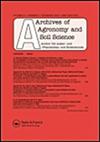Effect of herbicides on weed dynamics, soil fertility, energetics and productivity of upland rice in an acidic subtropical soil of the Eastern Himalayas, India
IF 1.8
4区 农林科学
Q1 AGRONOMY
引用次数: 0
Abstract
ABSTRACT Weed management in upland rice under subtropical climate with high rainfall is challenging. The diverse weed flora in upland rice ecosystem emerges in several flushes, necessitating sequential application of herbicides. A 4-year study conducted in Meghalaya (950 m above sea level), India indicated that sequential application of Cyhalofop butyl [2-{4-(4-cyano-2-fluorophenoxy) phenoxy} propionic acid, butyl ester (R)], a grass weed killer high efficacy low volume herbicide applied 80 g ha−1 at 25 days after sowing (DAS) and 2,4-D, a broadleaf weed killer herbicide applied 0.75 kg ha−1 at 35 DAS was effective for weed control and produced significantly higher grain yield (3572 kg ha−1) of rice with the highest weed control efficiencies than other treatments. Application of Pretilachlor followed by (fb) 2,4-D or Fenoxaprop-p-ethyl fb 2,4-D yielded significantly higher chlrophyll (chl) a, chl b and total leaf chl content compared with other herbicides at 90 DAS. The highest net energy (111,443 MJ ha−1), energy profitability and benefit:cost ratio was recorded with sequential application of Cyhalofop butyl and 2,4-D. Thus, sequential application of Cyhalofop butyl and 2,4-D could provide a sustainable weed management option in upland rice under high rainfall conditions in the Eastern Himalayas, India.除草剂对印度喜马拉雅山脉东部亚热带酸性土壤中旱稻杂草动态、土壤肥力、能量学和生产力的影响
亚热带多雨气候下旱地水稻杂草管理具有挑战性。旱地水稻生态系统杂草区系的多样性是分几期出现的,需要连续施用除草剂。在印度梅加拉亚邦(海拔950米)进行的一项为期4年的研究表明,在播种后25天连续施用Cyhalofop丁基[2-{4-(4-氰基-2-氟苯氧基)苯氧基丙酸丁基酯[R],这是一种高效小体积除草剂,每次施用80 gha - 1 (DAS)和2,4- d,在35 DAS施用0.75 kg ha - 1的阔叶除草剂对杂草控制有效,水稻产量显著提高(3572 kg ha - 1),防杂草效率最高。与其他除草剂相比,在90 DAS时,先施用(fb) 2,4- d或Fenoxaprop-p-ethyl fb 2,4- d的叶叶绿素(chl) a、chl b和叶片总chl含量显著高于其他除草剂。连续施用溴化丁基和2,4- d时,记录了最高的净能量(111,443 MJ ha - 1)、能量盈利能力和效益:成本比。因此,在印度东喜马拉雅地区高降雨条件下,连续施用氯氟草酰丁基和2,4- d可以为旱稻提供可持续的杂草管理选择。
本文章由计算机程序翻译,如有差异,请以英文原文为准。
求助全文
约1分钟内获得全文
求助全文
来源期刊

Archives of Agronomy and Soil Science
AGRONOMY-SOIL SCIENCE
CiteScore
5.50
自引率
4.20%
发文量
107
期刊介绍:
rchives of Agronomy and Soil Science is a well-established journal that has been in publication for over fifty years. The Journal publishes papers over the entire range of agronomy and soil science. Manuscripts involved in developing and testing hypotheses to understand casual relationships in the following areas:
plant nutrition
fertilizers
manure
soil tillage
soil biotechnology and ecophysiology
amelioration
irrigation and drainage
plant production on arable and grass land
agroclimatology
landscape formation and environmental management in rural regions
management of natural and created wetland ecosystems
bio-geochemical processes
soil-plant-microbe interactions and rhizosphere processes
soil morphology, classification, monitoring, heterogeneity and scales
reuse of waste waters and biosolids of agri-industrial origin in soil are especially encouraged.
As well as original contributions, the Journal also publishes current reviews.
 求助内容:
求助内容: 应助结果提醒方式:
应助结果提醒方式:


